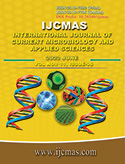


 National Academy of Agricultural Sciences (NAAS)
National Academy of Agricultural Sciences (NAAS)

|
PRINT ISSN : 2319-7692
Online ISSN : 2319-7706 Issues : 12 per year Publisher : Excellent Publishers Email : editorijcmas@gmail.com / submit@ijcmas.com Editor-in-chief: Dr.M.Prakash Index Copernicus ICV 2018: 95.39 NAAS RATING 2020: 5.38 |
The pest of rice bugs (Leptocorisa oratorius Fabricius) is very dangerous for rice plants, especially when the rice plants begin to have grain bodies, therefore monitoring is necessary at all times in the field. The population dynamics of the pest of stink bugs was highest during the third week of 2.78 and the lowest at the second and fifth weeks of 0.21 respectively. The intensity of the pest attack was the smallest during the third observation, which was 9% and the highest at the sixth observation reached 73%. The development of natural enemy populations in each observation seemed to dominate the ladybugs, the highest was achieved in week VIII as many as 35, with a total population of 74 individuals. Followed by 13 spiders, the highest at week V as many as 3 tails, then 6 butterflies and wasps each. The last dragonfly with a population of 4 tails. The correlation between insect pests (stink bugs), and natural enemies with temperature and humidity did not have a significant relationship. Only the intensity of pest attack with temperature had a significantly negative relationship, with the regression equation Y = 1.52 - 0.046 X1 (Y = intensity of pest attack of stink bugs, and X1 = temperature).
 |
 |
 |
 |
 |